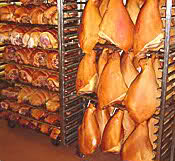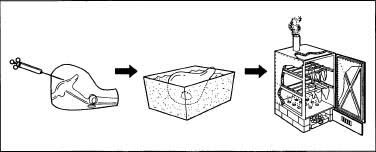 Smoked ham is a popular serving of meat, cut from the pork leg. It is cured with salt and spices, then subjected to slow and steady heat for varying periods. The smoking is carried out in a special chamber called a kiln.
Smoked ham is a popular serving of meat, cut from the pork leg. It is cured with salt and spices, then subjected to slow and steady heat for varying periods. The smoking is carried out in a special chamber called a kiln.
History
Foodstuffs were originally smoked as a means to preserve them. The practice may have started as early as the Stone Age and was probably discovered by accident when food was left out in the sun. The discovery of fire would have made the smoking of foods more prevalent. Throughout the centuries, until the development of refrigeration, smoking and salting meat for future use was a regular practice.
Chemicals released from the wood during the smoking process slows the growth of microorganisms. Likewise, in curing, salt reduces the amount of available water for bacteria to grow.
Pork has always been a popular meat for many civilizations due to the ease of raising pigs and preserving the meat. People began raising pigs about the same time that they established group settlements. By 600 B.C. , pig breeding was a thriving industry. Pigs were brought to the New World by Spanish explorer Hernando de Soto in the sixteenth century and soon became a major commodity here as well.
A number of cultures, such as Orthodox Jews and Muslims, forbid the eating of pork. This food prohibition dates to ancient times when Egyptians only ate pork during the feats of the god Osiris.
Raw Materials
Today, pigs are raised around the world, primarily in areas of temperate climates and dense human populations. China and the United States are the largest producers of pigs. Pig breeding incorporates a combination of pen-rearing and pasture-feeding. Domesticated pigs are fed a diet consisting of corn, grain, roots, and fruits.
Domestic pigs generally reach their market weight of 175-240 lb (79.4-108.9 kg) between the ages of five and 11 months. At that time they are taken to the slaughterhouse. The specific cuts are then created from the carcasses. The ham portion, cut from the leg, is then cured and smoked.
Before smoking, the pork is submerged in a brine solution containing water, salt, and sugar. Pickling spices (mace, allspice, cloves, cinnamon, peppercorns, and bay leaves) and garlic may also be added.
Using the correct type of wood is essential to successful smoking. The wood must be one that burns slowly and steadily. Non-resinous woods, such as beech, oak, chestnut, and hickory are the most common types used for smoking. Aromatic herbs such as juniper, laurel, sage, and rosemary may also be added. Conversely, woods containing resin, such as pine, will impart a bitter taste to the meat.
Smoking kilns are built in a variety of fashions. They can be brick chimney-like structures or stainless-steel drums. The inside can be fixed with racks or hooks. The fuel is loaded into the bottom and covered with a perforated plate so that the smoke can filter through to the ham.

The ham is injected with brine, then soaked in a brine solution. The ham is then hung and smoked in a kiln.
The Manufacturing Process
Brining the ham
* 1. Before the ham can be smoked, it must be soaked with a salt solution. First the solution is injected from a brine pump into the thickest part of the meat, preferably near the bone. Similar to a hypodermic needle, the brine pump has a long hollow tube with rows of holes down the sides. As the plunger is depressed, the brine is forced through the holes into the meat tissues.
A typical brine solution might be composed of 5 gal (19 1) of water, 5 lb (2.3 kg) of salt, 1 lb (0.5 kg) of white sugar, and 1 oz (28 g) of saltpeter (sodium nitrate). If a mild cure is desired, the ratio is 1 fl oz/lb (28 g/0.5 kg) of meat. For a stronger cure, the ratio is increased to 1.5 fl oz/lb (42.5 g/0.5 kg).
Soaking the ham
* 2. The ham is then immersed in the remaining brine for a period of 10-16 days depending on weight. The ham and the brine are inspected daily. The brine is overhauled, or turned over, every three days. Overhauling prevents the brine from becoming weak on top and heavy on the bottom. A large wooden paddle is used to remix the brine.
Rinsing and drying the ham
* 3. After the brining is complete, the ham is rinsed thoroughly with fresh water.
* 4. It then is hung or loaded onto racks to dry for a period of a few days to several weeks. During the drying period, a crust may form on the ham. This crust is shaved off and discarded.
Smoking the ham
* 5. Several hams are smoked together. They can be hung from meat hooks in a large kiln or placed on racks in smaller smokers. The smoker is kept at a temperature of 70-80°F (21-26°C). Wood chips are used rather than logs to create a slow burning fire. The chips are stirred, or stoked, regularly. The amount of time that the ham remains in the smoker is determined by the desired intensity of flavor. That period can be as little as 48 hours or as much as six weeks.
* 6. When smoking is completed, the hams are packaged in shrink wrap and shipped in refrigerated trucks to retail outlets and restaurants.
Quality Control
Pig farming and pork production is closely regulated by government agencies such as the United States Department of Agriculture (USDA). For example, according to USDA standards, a cut of meat marketed as ham must come from the hind leg of a hog. Meat cut from the front leg cannot be called a ham, but rather a pork shoulder. Additionally, the use of hormones in pig farming is illegal.
Pigs are extremely susceptible to several diseases, including foot-and-mouth disease, anthrax, and hog cholera. To prevent the occurrence of these diseases, pigs are often treated with antibiotics. In those cases, a withdrawal period is required between the time the drugs are administered and the time that the animals are slaughtered. The USDA’s Office of Food Safety and Technical Service conducts random tests at slaughterhouses to test the pork for antibiotic residues.
Government agencies also set rules for the operation of slaughterhouses. In the United States, the Federal Meat Inspection Act of 1967 includes guidelines set out in the Humane Slaughter Act of 1958. Under these regulations, animals must be rendered unconscious before they are killed. This is accomplished by stunning or gassing the animals.
Byproducts/Waste
Waste material from hog farms are often piped into open-air pits or waste lagoons. This has caused concern among environmental agencies that toxic gases emanating from the bacteria that feeds on the decomposing waste material will make its way into the groundwater. Contaminating this environmental hazard will result in increased safeguards imposed on the farmers, which could impact those farmers economically.
The Future
In the early months of 2001, a severe outbreak of foot-and-mouth disease occurred in the United Kingdom. By mid-year, 2.8 million animals had been affected. The disease, which is characterized by sores and blisters on the hooves and mouths of livestock, is extremely contagious. Although humans cannot contact foot-and-mouth disease, infected animals must be destroyed
The outbreak caused world-wide concern. Imports of meats from the United Kingdom were restricted. A number of tourists sites, such as Stonehenge, were closed to visitors. Travelers returning from the United Kingdom were required to clean their shoes in disinfectant at airport customs points. Whether or not the epidemic can be contained and its long-term effect on pork production is yet to be seen.
At the end of the twentieth century, pork farmers were facing a severe economic downturn. An increase in hog production was offset by the closing of a significant number of slaughterhouses. This caused hog prices to fall from 55 cents a lb/kg to eight cents a lb/kg.
Where to Learn More
Books
Erlandson, Keith. Home Smoking and Curing. London: Vermilion, 1977.
Lang, Jenifer Harvey, ed. Larousse Gastronomique. New York: Crown Publishers.
Nissenson, Marilyn, and Susan Jonas. The Ubiquitous Pig. New York: Harry N. Abrams, Inc., 1992.
Sleight, Jack, and Raymond Hull. Home Book of Smoke-Cooking Meat, Fish & Game. Harrisburg, PA: Stackpole Books, 1971.
Other
United States Department of Agriculture Web Page. December 2001. .
– Mary McNulty
Source: “Smoked Ham”. How Products Are Made. Volume 7
Do you like this money making business ideas? content“>then please consider subscribing to our PINOY BISNES ![]() RSS feed. You can also subscribe by email and have new business ideas sent directly to your inbox. (Once you entered your e-mail address, you need to login to your e-mail account and click the link to confirm your subscription).
RSS feed. You can also subscribe by email and have new business ideas sent directly to your inbox. (Once you entered your e-mail address, you need to login to your e-mail account and click the link to confirm your subscription).




Recent Comments